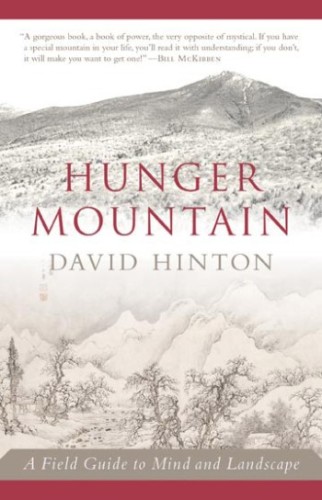by David Hinton
Shambhala, 2012
If you are peering into one of those GPS devices many people now find indispensable, everything, anywhere, is shown in relation to your own location. With GPS, you’re always at the center of the world, and maybe that’s what users like about this technology. By contrast, with a conventional map, before determining routes to destinations you first need to find yourself.
The question of where we’re located, not only on the land but also in the cosmos, is central to David Hinton’s new book. Hunger Mountain: A Field Guide to Mind and Landscape is a profound reconsideration of language and consciousness and also a series of crisp, alert essays by a Vermonter who frequently hikes up the mountain for which the book is named to remind himself that “the center is elsewhere.”
Hinton is our era’s most prolific translator of Chinese poetry and prose, the first writer in more than a century to translate into English the four key texts of ancient Chinese philosophy – Tao Te Ching, the Analects of Confucius, and the writings of Chuang Tzu and Mencius – as well as a dozen collections of Chinese poetry.
Hunger Mountain is more openly personal than Hinton’s splendid translations, with an erudite yet friendly narrator who takes habitual walks that become meditations. As in Thoreau’s Walden, there are chapters named by topic, including “Sincerity,” “Friends,” and “Ritual.” Other chapters have more elliptical titles: “Dragon Bone,” “Breath-Seed Home,” “Loom of Origins.”
The phrase Hunger Mountain sounds evocative and figurative: a metaphor for life’s appetites and struggles. But it’s also the name of a specific place, a still entirely undeveloped peak near Waterbury Center in Vermont, and a steady companion in Hinton’s everyday landscape. We climb a mountain or stand at the seacoast or gaze at the celestial night sky and feel...smaller, which somehow feels...great. At those moments, yes, “The center is elsewhere.” There’s an uncanny relief in the sensation of being less important, less pivotal. Less self-involved.
One of Hinton’s fascinations is the artistry of description. How do humans record actuality transpiring, in our minds and around us, near and way beyond? His own guides in this quest are the poet-sages of China’s faraway past, legendary chroniclers whose poems and prose are extremely distilled, with extraordinary brevity and clarity. In many of the ancient writings he has translated, there is no narrating “I,” yet the work has astonishing immediacy.
Hinton wonders whether the pictographic Chinese language provides more intimate access to the “ten thousand things” of existence than an alphabetical language such as English can yield. Based on phonetics, languages like English convey the sound of a voice, but not visual images as directly.
And Hinton asks a reader to consider the prelinguistic sensibility of our ancestors, before anyone painted the shape of a running deer on a cavern wall, or carved some depiction of forest or lake or star on a stone or a bone, thereby marking a rupture between human self-awareness and the entirety of everything else. The word nature betrays that breach, whereby people and everything else are sundered by language with its abstractions and categories.
A prelinguistic mind is difficult to imagine, now that our very thoughts take form as words. Is it possible, even for a moment, to shift the mind to a nonhuman vantage? To be self-forgetful, meanwhile utterly aware?
Long after finishing the book, I found myself thinking about the Buddhist proposition that presence (all that we encounter, materially) is no more real than absence (the boundless pregnant latency that everything arises from and dissolves into).
Chinese landscaping paintings always have areas of apparent nothingness, effusions of mist (or time passing?) that appear to be empty space. For Hinton, Hunger Mountain is a span between heaven and earth, crisscrossed by hawks and continually in flux, with leaves sprouting or spreading or falling. He evokes the mountain’s creation as an upheaval of colliding continents, glacial carving, and eons of weathering. The mountain is, and its cataclysmic change over thousands of centuries also is, a never-ending occurrence.
Can we comprehend time and space as inseparable, simultaneous? Not different dimensions in phenomena but one dwelling? This vision is what the old Chinese sages offer. This conception is also what contemporary physicists and cosmologists are asking us to consider.
Hinton repeatedly questions whether humans should claim primacy as a species, or place ourselves at the center of reality. That is too heavy a burden, and the consequences of our presumptuous actions are too huge. Even so, he wonders if the cosmos has evolved a special role for us: we’re the means (in language, in the arts, in our sciences, too) by which existence expresses awareness.
These are thoughts aroused by a mountain hike in the good company of David Hinton.


